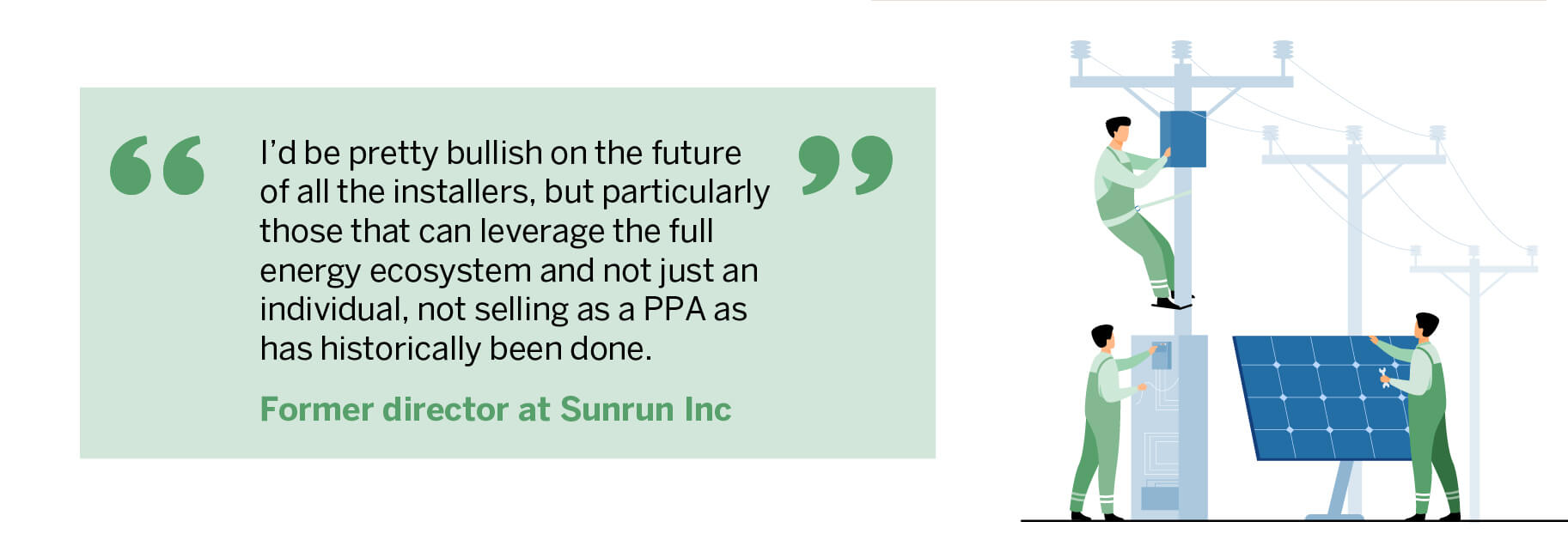The headline move is an expansion of the solar investment tax credit (ITC), which according to the Solar Energy Industries Association (SEIA) has helped the industry grow by over 200% since 2006.1https://www.seia.org/initiatives/solar-investment-tax-credit-itc
The ITC was due to expire next year but the IRA means that anyone who installs a photovoltaic (PV) system between 2022 and 2032 will receive a 30% tax credit (decreasing to 26% and 22% for those installed in 2033 and 2034 respectively). Storage equipment expenses now also include devices with a capacity rating of 3 kilowatt-hours or greater, which many believe will transform the storage market.2https://www.energy.gov/eere/solar/articles/solar-investment-tax-credit-what-changed
How significant is the US Inflation Reduction Act to the solar industry?
The impact of the IRA on solar installers is “probably going to be greater than… we forecasted years ago”, a former director at Sunrun Inc told Third Bridge Forum. Without the ITC extension, the specialist believes businesses that rely on direct sales – including Sunrun, Sunnova and SunPower – would have started to find themselves in a tight spot. “As you start paring back your cost stack, it gets challenging to continue to pay those sales and marketing costs,” the expert said.
For commercial and industrial, and utility-scale PV systems, the ITC will run until greenhouse gas emissions are 75% less than 2022 levels. “So that likely extends it out well beyond even 2032,” the expert said. “We may have a 15-, 20-year-plus extension for that space,” they added.
The IRA also extends tax credits for community solar projects. From next year, small community solar projects will be able to earn additional credits based on fulfilling domestic content and other specifications (10%), or if the project is part of a low-income residential building project or qualified low-income economic benefit project (20%).3https://www.solarunitedneighbors.org/learn-the-issues/solar-incentives/how-the-inflation-reduction-act-helps-you-and-your-community-go-solar/ “They are stackable… so there are target areas where you could easily get a 40% or a 50%, and 60%, potentially, credit adder, which makes these economics extremely attractive to developers,” the former Sunrun director said.
However, the California Public Utilities Commission’s (CPUC) proposed Net Energy Metering (NEM) 3.0 – a new version of net energy metering policy – is causing a stir. One of the main sticking points, opponents say, is the monthly grid participation charge of approximately USD 8 per kilowatt. “Any grid access fee becomes pretty challenging to overcome, even in an ITC world with an extension, that can really hamper the ability to operate in California successfully.” Another debate is that proposals to reduce export compensation to customers will significantly lower the value of NEM credits, as the current compensation structure for solar owners, it is argued, is shifting costs to non-solar owners and in turn causing electricity rates to rise.
The former Sunrun director acknowledged that NEM 3.0 poses a long-term threat to developers because “any impact on California has downwind effects on other markets”. However, they also said that momentum around real-time pricing suggests a new NEM regime “could become a little bit irrelevant… within the next three or four years”.
What markets could the ITC extension open up?
We were told the ITC extension has created ripe conditions for the market in Texas to “start taking off”. While certain criteria must be met, the specialist said it is “hard to envision a zip code” that would not be eligible for the tax credits. Texas could soon become the “hottest solar market in the US”, driven also by the fact the state has been subject to high utility rate increases due to its exposure to natural gas. Solar penetration is “easily less than 1%” in Texas, we were told, and “probably multiple percentage points below there”. Our expert cautioned that players should be careful with their pricing, as natural gas prices could normalise and therefore be less of a factor in any decision to invest in solar.
In the future, the specialist said solar policy could interplay with electric vehicle and energy storage policy, ultimately encouraging what they described as “energy as-a-service” bundling. They speculated that developers might collaborate with each other, highlighting Sunrun’s Ford partnership as an early example of this trend. “I think you’re going to see more partnerships, because it’s really hard to build out all those services in-house, at least initially.” This could take “years to flesh out”, we heard, but market competition will “lead to where that ultimately lands”. According to the expert, Sunrun is best positioned to benefit from offering products and services under one bundle. “You have to look at at least who is in pole position right now, who is the market leader,” they said. “I think that would be Sunrun. They already have the relationship with Ford.”

Battery storage is a “critical” piece of the clean energy puzzle
Solar’s role in the energy mix was apparent this September after California’s seven-day heatwave that threatened rolling blackouts. On one of the days, solar energy stored in batteries shifted 3,000 megawatts to the grid from midday to the evening hours, a former director at CPUC said. While this was encouraging, the challenge operators are experiencing as the world moves to more variable resources is understanding how to blend them throughout the day as demand changes.
The California Independent System Operator (CAISO) sees battery storage as a “critical piece of the puzzle”, the expert added. CAISO is committed to working with battery owners and developers to “get to a point where the market works for everybody”. Its biggest concern is ensuring that batteries have enough charge in them to accommodate peak energy usage, and when the system is under pressure.
A board member at System One Holdings LLC also told us the battery market has become “incredibly price-competitive” and commoditised for energy storage, with RFQs extremely cost-centred and some utilities even demanding 10-20% price cuts. At the same time, the price of lithium-ion batteries has fallen drastically in recent years, increasing their uptake despite serious concerns regarding safety (fires) and sustainability (lack of recycling and cobalt mining practices). The specialist said lithium-ion “may not be the long-term winner, despite the billions of dollars of investment that’s been made in it”.
Solar energy still only represents about 3% of US energy production, but it is clear which way the wind is blowing. In May this year, California broke its record for renewable energy when renewables nearly provided enough energy to meet almost all consumer demand (99.87%) at one point during the day.4https://www.google.com/url?q=https://renewablesnow.com/news/california-iso-sets-record-of-almost-100-renewables-on-grid-783157/&sa=D&source=docs&ust=1666113364175375&usg=AOvVaw0sGwERlq7gpKpTcfeEQz37 The ITC extension, the SEIA said, has provided market certainty for companies to make long-term investments in solar that ultimately drive competition and innovation. It has also given a “lifeline”, as one expert noted, to the direct-to-home sales business model.
However, accomplishing solar energy goals remains dependent on resolving several other debates and challenges, including significant uncertainty in the debate over net metering, challenges with grid interconnection and building sufficient transmission wires, challenges over resource planning to account for solar intermittency, and debates over how exactly to incentivise battery energy storage, which is seen as a key lynchpin in the transition to renewables.
The information used in compiling this document has been obtained by Third Bridge from experts participating in Forum Interviews. Third Bridge does not warrant the accuracy of the information and has not independently verified it. It should not be regarded as a trade recommendation or form the basis of any investment decision.
For any enquiries, please contact sales@thirdbridge.com



